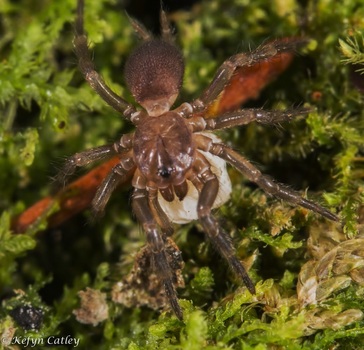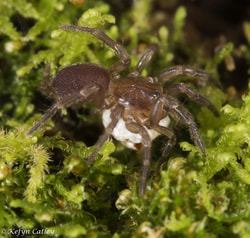Much of our work is focused on understanding ranges of species and the connectivity and health of the populations within the range. This means we spend time collecting data in the field, running lab samples, and spending a lot of time using quantitative methods on my computer. Our field and lab work has ranged from simple count surveys, to environmental DNA collection and DNA extraction, to experiments with mesocosms. While working on the computer, we heavily use ArcGIS/QGIS, R, and sometimes python/perl.
Disclaimer: I've tried to keep the explanations as simple as possible for any general public visitors. If you want to talk in detail about the more "hard" science behind these projects or past projects, don't hesitate to contact me. If you are a non-scientist and things are confusing, let me know so I can fix them.
Disclaimer: I've tried to keep the explanations as simple as possible for any general public visitors. If you want to talk in detail about the more "hard" science behind these projects or past projects, don't hesitate to contact me. If you are a non-scientist and things are confusing, let me know so I can fix them.
Cold-Adapted Amphibians
|
Species' Ranges
I am broadly interested in how species' ranges change over time and what factors on the landscape influence populations. Currently, I am working on predicted changes in the face of climate change for cold-adapted amphibians. I'm working towards incorporating not just climate, but dispersal and landscape features to inform species distribution models. |
 One of the ponds that make up the last population of Northern Leopard Frogs in Washington.
One of the ponds that make up the last population of Northern Leopard Frogs in Washington.
Molecular Ecology: Conservation and Landscape Genetics
Genetics can be very important for conservation efforts. These molecular methods allow us to estimate the effective population size and the amount of migration occurring across populations. My most recent completed project of this was with the last remaining Northern Leopard Frog population for Washington Department of Fish and Wildlife. I used genetic data integrated with population modelling.
I have also been working through the effects of sampling design on the inferences from studies implementing landscape genetics. This work has been focused on the Columbia Spotted Frog in Northern Idaho.
Lastly, I have helped design and run the qPCR assays for the signal crayfish and the Cascade's frog, as part of a multi-species project in colloboration with the U.S. Forest Service.
Genetics can be very important for conservation efforts. These molecular methods allow us to estimate the effective population size and the amount of migration occurring across populations. My most recent completed project of this was with the last remaining Northern Leopard Frog population for Washington Department of Fish and Wildlife. I used genetic data integrated with population modelling.
I have also been working through the effects of sampling design on the inferences from studies implementing landscape genetics. This work has been focused on the Columbia Spotted Frog in Northern Idaho.
Lastly, I have helped design and run the qPCR assays for the signal crayfish and the Cascade's frog, as part of a multi-species project in colloboration with the U.S. Forest Service.
|
Conservation Ecology and Physiology To help inform species models of where populations are found, it is beneficial to develop a strong understanding of what sets their limits. I have done research on wood frog stress response, behavioral changes, and disease status (for Ranaviruses) when growing up in polluted ponds. We had individuals we raised from eggs, as well as those caught in the field, to look for differences between growing up in potentially polluted ponds vs. being from potentially polluted ponds. |
Species of Focus Photos
In addition to these two species, the Wood Frog (left/top) and Columbia Spotted Frog (right/bottom), I have also spent time during my dissertation working on various projects focused on Sonoran Tiger Salamanders, Northern Leopard Frogs, American Bullfrogs, Mountain Yellow-Legged Frogs, and Cascade's Frogs.
|
|
|
Microhexura montivaga (Spruce-Fir Moss Spider)
|
The only species of spider listed as federally endangered. This tiny spider (only a few milimeters) was the focus of my research at Western Carolina University. It is interesting as the only other species in the genus is found out in the Pacific Northwest. It is a Diplurid; one of the funnel-web tarantulas. My thesis had three main parts: 1) Ecological niche models of the species' range, specifically looking for which climate variables influence the probability of presence 2) Microhabitat measurements of humidity and temperature within the moss mats. I was interested in comparing sites where the spider is present and absence. In addition, I compared the microhabitat to different areas of the range. 3) Cataloging of microfauna from soil samples. This was done to look for potential prey and predators within the moss mats. This research was done in close conjunction with U.S. Fish and Wildlife and took place in North Carolina and Virginia. I owe a big thank you to Kefyn Catley for being a great advisor and allowing me to use his images of this beautiful spider. |
Limpets and their Algal Epibionts
|
During my undergraduate career at University of Washington, I looked into the effects of ending up with algae growing on the shells of limpets. I did three experiments here:
1) The probability of landing right-side up when algae was present or absent. 2) The changes that occur relative to the drag forces. This was done using a flume. 3) Using a wind tunnel and lights to simulate an environement which may lead to the limpets facing the stress of drying out (dessication). During my time at Friday Harbor Labs, I worked on a website which addressed this and contains other information on my favorite algal species, Acrosiphonia coalita |
|



